(完整版)初中英语语法之非谓语动词1讲解练习答案
非谓语动词(动名词、动词不定式)总结及练习(附答案)

非谓语动词(动名词、动词不定式)总结及练习非谓语动词在句子中充当除了谓语....以外其它成份的动词形式,不受人称和数的限制。
在英语中,非谓语动词主要有动名词和动词不定式两种形式。
第一部分动名词1.0动名词是在动词后面+ ing (doing)的形式,把动词变成名词来使用。
比如:live → living, see → seeing, go → going,凡此种种。
2.0 动名词在句子中的成份2.1 动名词做主语e.g. Seeing is believing. seeing为动名词,在句子中做主语Learning Japanese is hard. 为动名词,在句子中做主语2.2 动名词作宾语, 此时多与一些固定的谓语动词作搭配, 见附表e.g. I like reading.He enjoyed living in France.2.3 动名词作介词的宾语,常常与类似如下短语的介词连用,如:dream of, keep awayfrom, be good at, be interested in …e.g. He is interested in drawing. 动名词drawing作in的宾语Please keep away from lying. 动名词lying作from的宾语2.4 动名词作表语e.g. Seeing is believing. 动名词believing作表语My hobby is skating. 动名词skating作表语2.5 动名词作定语, 对修饰的名词形成一种定义e.g. a dining room, a swimming pool, a waiting room…2.6 动名词作状语,逻辑主语须与主句主语报纸一致e.g. Hearing the good news, she couldn’t helping laughing. (时间状语)Having received the letter, I decided to write back. (时间状语)Having been to the Great Wall for many times, he didn’t go last week. (原因状语)Working hard, you will succeed.(条件状语)Though working hard from day to day, he didn’t get rich. (让步状语)2.7 动名词作宾语补足语,常与感官等动词连用e.g. I saw him leavingPlease keep him working.第二部分动词不定式1.0 动词不定式也是一种非谓语动词形式,其结构为“to+动词原形”,其中to不是介词而是动词不定式的符号,动词不定式没有人称和数的变化。
非谓语动词讲解和练习(附答案)

非谓语动词非谓语动词是英语语法中的一个重要概念,指的是在句子中不能单独作谓语,但又具有动词特征的动词形式。
一、种类非谓语动词主要包括三种形式:不定式(Infinitive)、动名词(Gerund)和分词(Participle)。
1.不定式基本形式是“to + 动词原形”(有时可省略to),例如“to study”、“to play”等。
它具有名词、形容词和副词的特征,可在句中充当主语、宾语、表语、定语、状语和补足语等成分。
To see is to believe.(作主语和表语)I want to learn English.(作宾语)2.动名词形式上是动词原形加-ing,和现在分词的形式一样,如“swimming”、“reading”等。
动名词在句中主要起名词的作用,可充当主语、宾语、表语和定语。
Swimming is my favorite sport.(作主语)I enjoy reading books.(作宾语)3.分词现在分词:也是动词原形加-ing,它既有动词特征,又有形容词和副词特征,可作定语、状语、表语和补足语。
The running boy is my brother.(作定语)Hearing the news, she couldn’t help crying.(作状语)过去分词:通常是动词原形加-ed(规则变化)或有其特殊的不规则变化形式,如“broken”、“written”等。
过去分词常表示被动或完成的意义,同样能充当定语、状语、表语和补足语等成分。
The broken cup is on the table.(作定语)Given more time, I can do it better.(作状语)二、用法区别1.作主语时不定式作主语常表示具体的某一次动作或行为,常用“It + be + 形容词+ (for/of sb.) + to do sth.”这样的结构,It is important for us to learn English well.动名词作主语往往表示抽象的、一般性的行为或概念。
非谓语动词讲解及练习(含答案)
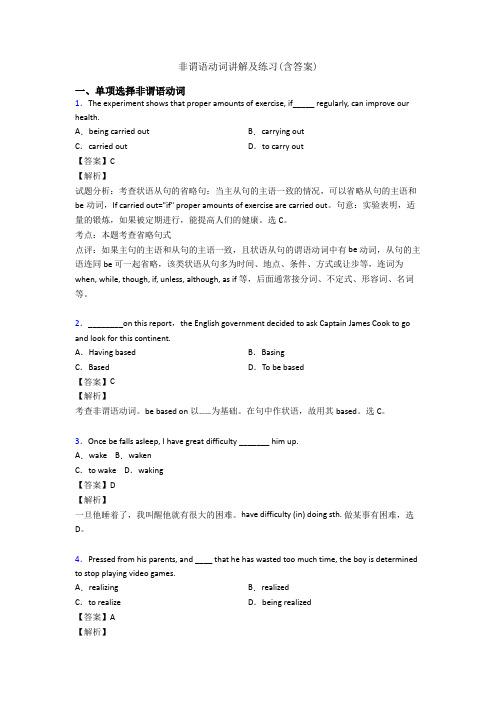
非谓语动词讲解及练习(含答案)一、单项选择非谓语动词1.The experiment shows that proper amounts of exercise, if_____ regularly, can improve our health.A.being carried out B.carrying outC.carried out D.to carry out【答案】C【解析】试题分析:考查状语从句的省略句:当主从句的主语一致的情况,可以省略从句的主语和be动词,If carried out="if" proper amounts of exercise are carried out。
句意:实验表明,适量的锻炼,如果被定期进行,能提高人们的健康。
选C。
考点:本题考查省略句式点评:如果主句的主语和从句的主语一致,且状语从句的谓语动词中有 be 动词,从句的主语连同be 可一起省略,该类状语从句多为时间、地点、条件、方式或让步等,连词为when, while, though, if, unless, although, as if 等,后面通常接分词、不定式、形容词、名词等。
2.________on this report,the English government decided to ask Captain James Cook to go and look for this continent.A.Having based B.BasingC.Based D.To be based【答案】C【解析】考查非谓语动词。
be based on以……为基础。
在句中作状语,故用其based。
选C。
3.Once be falls asleep, I have great difficulty _______ him up.A.wake B.wakenC.to wake D.waking【答案】D【解析】一旦他睡着了,我叫醒他就有很大的困难。
初中英语语法非谓语动词讲解(1)

初中英语语法非谓语动词讲解(1)一、选择题1.The price of housing in Nanjing is so high that many people can’t afford ________ a flat. A.buying B.to buy C.bought D.buy2.—My eyesight is getting worse these days. I'd like to have my eyes________. —Perhaps you should consider ________the time on the computer.A.checked; reducing B.to check; reducingC.checked; to reduce D.checking; to reduce3.— Would you mind ________ in the hall?—Of course not.A.smoked B.don't smoke C.not smoking D.not to smoke 4.Peter enjoys ________ pictures in the country on Sundays.A.draw B.drawing C.to draw D.drew 5.WeChat has given up ________ in a popular emoji (表情) recently. The “soldier face” emoji doesn’t have a cigarette in his mouth anymore.A.smokes B.smoked C.to smoke D.smoking 6.People are advised to avoid ________ their eyes, nose and mouth with unwashed hands. A.touch B.touched C.touching D.to touch7.Dad always tells me not ________ just for tests. Or, I’ll lose interest in learning.A.study B.studies C.studying D.to study8.—I hope to take the DIY course at weekends.—Good idea. ________ more about it, visit the website http://www. . please. A.Know B.To know C.Knowing D.To knowing 9.When I eat a mooncake, I prefer ________ it into small pieces before eating rather than________ it up straight.A.to cut;eat B.cutting;eat C.to cut;to eat D.cutting;eating 10.The joke was so funny that it made him ________ again and again.A.laughing B.laughed C.laugh D.to laugh 11.The way our students thought of ________ the classroom clean and tidy proved to be very useful.A.to keep B.keeping C.kept D.keeps12.My mother usually eats a little for supper________. She looks slimmer than before.A.to save money B.saving money C.to lose weight D.losing weight 13.My mother always teaches me how ________ water in my daily life. That really helps me develop a good habit of using water.A.to save B.saving C.saves D.saved14.________ more trees can help to protect the Earth and make it more beautiful. A.Planted B.Plants C.Plant D.Planting 15.Life is about waiting for the right moment_____, because everyone is in his own TIME ZONE.A.acting B.to act C.act D.acts16.Tina is showing off her new phone. She won't stop ________about it.A.talk B.to talk C.talks D.talking17.It’s my honor _____ to give a talk h ere.A.to invite B.to be invited C.inviting D.invite18.She couldn’t wait ________ her mother the good news.A.to tell B.telling C.to talk D.talking19.—I don’t know _____ remember the new English words.—Don’t worry! Try thinking about their pronunciation s.A.what to B.how to C.where to D.when to20.–Your robot has caught a virus and it no longer works properly.–Wow, ______ mess it has made! I really don’t know _______ to do with it.A.what, how B.how, how C.what a, what D.how, what 21.Dan shows an interest in musical instruments and is often heard _____ the guitar.A.play B.played C.playing D.to play22.一I'm considering how to my new job. Any suggestions?一It's only half an hour's walk, I advise you .A.to go; not to drive B.going; to driveC.to go; not driving D.going; not driving23.My uncle made up his mind to devote his life pollution happily.A.to prevent; to live B.to prevent; from livingC.to preventing; to live D.to preventing; from living24.Helen was made the task in two days.A.finish B.to finishing C.finished D.to finish25.________ ill, I can’t go to school today.A.Because of B.As C.Being D.With26.What ______ great fun we had ______ the film Jungle Book.A.a; to watch B./; watching C.a ; watch D./; to watching27.He tried to make himself ________ by his students, but he failed.A.understand B.understoodC.understands D.understanding28.A medical team, ________ five experienced doctors and ten skillful nurses, was sent to the earthquake-stricken area in Turkey.A.made up of B.made of C.made from D.made by29.My younger sister wants to get her ears ________ after graduation.A.pierced B.pierce C.piercing D.to pierce 30.—Sandy, your mobile phone is ringing.—Wait a moment 1 It's dangerous ________ it while crossing the street.A.answer B.to answer C.answering D.answers31.All of us should know what attention should be paid to __________ a more beautiful Huai'an.A.building B.to build C.build D.have built 32.Chinese spacecraft Tianwen I successfully landed on the Martian surface, ________ a historic accomplishment in China’s space development.A.marking B.to mark C.marked D.marks33.On her way home, Lucy saw a thief ______ in a shop. She stopped ______ 110 at once. A.steal; call B.to steal; callC.stealing; to call D.stealing; calling34.Mr. Grea found Tom a novel in class when he came in.A.is reading B.reading C.read D.to read35.I saw her flowers in the garden when I passed by.A.to water B.water C.watering D.watered36.---Is Jack in the next room ?---It’s hard to say. But I heard him _____ loudly when I passed by just now.A.speak B.to speak C.spoken D.speaking37.-Look! So many people are walking into the museum. What are on show?-Some 3D pictures by some modern artists.A.draws B.drew C.drawn D.drawing38.This food is cooked by a cook _____ Victor.A.call B.calls C.called D.calling39.Your hair is too long. You’d better _____.A.have it cut B.have cut it C.be cutting it D.to cut it40.My computer does n’t work. I decide to have it ______.A.repair B.repaired C.to repair D.repairing 41.—How much difficulty did you have ________ this problem?—________. It’s quite easy.A.to solve; Nothing B.to solve; None C.solving; None D.solving; Nothing 42.The film Hello, Mom! is such a moving film that I think it is well worth________ .A.to watch B.watching C.watches D.watch43.The details the teachers asks to pay attention to ________ our English are very important. A.to improve B.improve C.improving D.improved 44.—Did everyone attend the concert last night?—No, Emily preferred ________ TV at home to ________ the concert.A.to watch; attend B.to watch; attending C.watching; attend D.watching; attending 45.Many students admitted ________ games once in a while when they took online courses. A.play B.played C.playing D.to play 46.—What happened to Lucy? I saw her _______ in her seat just now.—She failed in the final exam. Let’s go to cheer her up.A.crying B.to cry C.cried D.to be crying 47.—Do you have any plans for the holiday?—Yes, I’m planning to travel to Jiuzhaigou. I’m looking forward to ________ the colourful lakesand amazing waterfalls.A.see B.seeing C.sees D.saw48.—You don’t know what great difficulty I had ________ to get the two tickets.—But the film is really worth _________ twice.A.managing; seeing B.to manage; seeingC.managing; being seen D.managed; to see49.A new high-speed railway ________ Yangzhou ________ Nanjing will be built. A.connected; and B.connects; with C.connected; to D.connecting; to 50.________ of the road ________ broken down. It needs ________.A.Three-fourths; was; repairedB.Three quarters; has; to repairC.Three-fourth; was; to be repairedD.Three quarters; has; repairing51.I think the film Roman Holiday is worth a second time.A.to watch B.watch C.watching D.being watched 52.The girl is often seen ____in the art room.A.practice drawing B.practised drawingC.to practice drawing D.practice to draw53.---Do you have any idea what Paul does all day ?--- As I know, he spends at least as much time playing as he .A.writes B.does writing C.is writing D.does write 54.The clothes need _________, but you _________do that by yourselves.A.washing; needn't B.washing; needn't toC.to be washed; don't need D.to wash; don't need to55.We should encourage our students _____ hard instead of ____ too much time playing games. A.work; spend B.to work; spendC.work; spending D.to work; spending56.He made up his mind to devote his life pollution happily.A.to prevent, to live B.to prevent, from livingC.to preventing, to live D.to preventing, from living57.His pronunciation is better, for he kept ______ a short passage after the tape every morning. A.to read B.readingC.read D.reads58.My mother often asks me to do some on Sunday.A.washing B.wash C.to wash D.washed59.---It is selfless ______ the doctor to devote all the time he had ________ for the patients.--I think so, they are so great.A.for; to care B.of; to care C.of; to caring D.for; to caring60.The girl is so helpful that she devoted all her spare time she had ________ others.A.to helping B.helping C.to help D.helped【参考答案】一、选择题1.B解析:B【详解】句意:南京的房价太高,很多人买不起房子。
初中英语常用语法知识——非谓语动词(含答案解析)
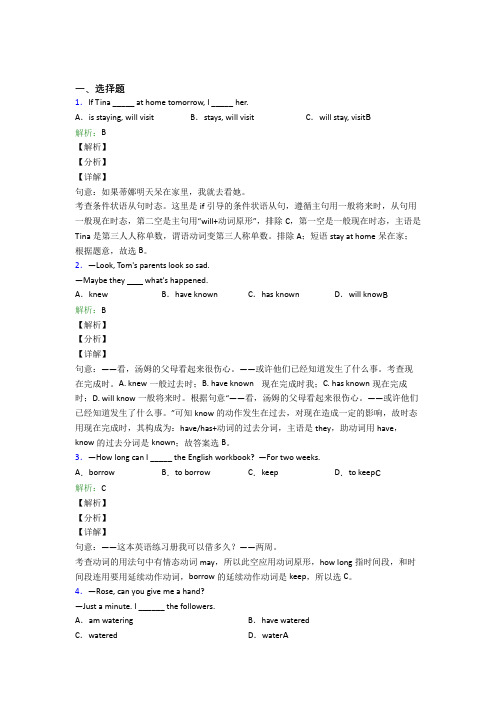
一、选择题1.If Tina _____ at home tomorrow, I _____ her.A.is staying, will visit B.stays, will visit C.will stay, visit B解析:B【解析】【分析】【详解】句意:如果蒂娜明天呆在家里,我就去看她。
考查条件状语从句时态。
这里是if引导的条件状语从句,遵循主句用一般将来时,从句用一般现在时态,第二空是主句用“will+动词原形”,排除C,第一空是一般现在时态,主语是Tina是第三人人称单数,谓语动词变第三人称单数。
排除A;短语stay at home呆在家;根据题意,故选B。
2.—Look, Tom's parents look so sad.—Maybe they what's happened.A.knew B.have known C.has known D.will know B解析:B【解析】【分析】【详解】句意:——看,汤姆的父母看起来很伤心。
——或许他们已经知道发生了什么事。
考查现在完成时。
A. knew一般过去时;B. have known 现在完成时我;C. has known现在完成时;D. will know一般将来时。
根据句意“——看,汤姆的父母看起来很伤心。
——或许他们已经知道发生了什么事。
”可知know的动作发生在过去,对现在造成一定的影响,故时态用现在完成时,其构成为:have/has+动词的过去分词,主语是they,助动词用have,know的过去分词是known;故答案选B。
3.—How long can I _____ the English workbook? —For two weeks.A.borrow B.to borrow C.keep D.to keep C解析:C【解析】【分析】【详解】句意:——这本英语练习册我可以借多久?——两周。
初中英语语法非谓语动词知识点讲解及专项练习

初中英语语法非谓语动词知识点讲解及专项练习一非谓语动词的概念在句子中充当除谓语以外的句子成分的动词形式叫做非谓语动词它不受人称和数的限制非谓语动词分为三种形式:不定式:to+动词原形动名词:动词原形+ing分词(现在分词和过去分词)二、动名词的用法动名词是由动词原形+ ing 构成,形式同现在分词形式一样,其否定形式是not + 动词原形+ ing。
1、动名词作主语:Talking like that is not polite. 那样谈话不礼貌。
Learning from others is important. 向别人学习很重要。
Putting on more clothes is not so good . 多穿衣服不一定好。
动名词作主语通常用一般式,可以像动词不定式一样,用it 先行词代替,而把动名词写在后面。
It's no use waiting here, let's go home. 在这儿等着也没用,我们回家吧。
It's very difficult climbing this mountain. 爬这座山很困难。
2、动名词作表语The nurse's job is looking after the patients. 护士的工作是护理病人。
Seeing is believing. 眼见为实。
3、动名词作定语She is studying in the reading room. 她在阅览室学习。
He slept in the sleeping bag. 他在睡袋里睡觉。
4、动名词作宾语Please stop smoking in the house. 请不要在家里抽烟。
I like reading in the forest. 我喜欢在树林里读书。
Do you mind my opening the windows? 你介意我打开窗户吗?She is found of collecting stamp. 她喜欢集邮。
初中英语语法非谓语动词附答案

初英语语法ENTERPRISEKINGSOFT OFFICE CORPORATION跟郭老师学初中英语语法:非谓语动词非谓语动词是河北中考的必考点。
从命题内容来看,动词不定式作主语、定语、宾语补足语;动词不定式与疑问词连用;部分动词后接不定式或动名词作宾语的区别;过去分词作定语等都是常考点。
从命题形式来看,以单项选择为主,一般占1分。
预计2016年,对非谓语动词的考查,动词不定式仍是热点。
2011—2015年河北中考试题分析表:(非谓语动词)年份题号题型分值2011 32 单项选择 12012 37 单项选择 12013 39 单项选择 12014 33 单项选择 12015 39 单项选择 1非谓语动词是一些特殊的动词,它们在句中不能单独作谓语,而有谓语以外的其他语法功能,在句子中不受主语的人称和数的限制,但仍有时态和语态的变化,也可以带宾语和状语,构成非谓语动词短语。
非谓语动词分动词不定式、动名词和分词三种。
动词不定式由“to +动词原形”构成,有时在特殊情况下to可以省略。
动词不定式具有名词、形容词和副词的特征,同时也具有动词的部分特征,能充当主语、宾语、宾语补足语、表语、定语、状语等成分。
动名词由动词加-ing构成,在句中作主语、宾语、表语和定语。
分词分为现在分词和过去分词两种。
它们在句中作定语、状语、表语和补语。
①动词不定式功能例句主语To speak English well isn’t an easy job.宾语They decided to change their mind.宾语补足语He helps the little girl to finish her homework every day.定语He is always the first to come and the last to leave.表语Our plan is to set up another middle school for the children.状语目的Every morning he gets up very early to exercise.结果He returned home to learn his son had gone to the countryside.1. 不定式作宾语(1)一些谓语动词后只能用不定式作宾语,常见的这类词是表示命令、打算或希望的,如:would like,like,want,wish,hope,decide,plan,expect等。
初中英语非谓语动词解题技巧讲解及练习题(含答案)及解析

初中英语非谓语动词解题技巧讲解及练习题(含答案)及解析一、非谓语动词1.—Why were you so angry with your daughter?—She was busy _______and taking selfies(自拍) when I was talking to her.A. textingB. to textC. textD. texted【答案】 A【解析】【分析】句意:——你为什么对你女儿这么生气?——当我和她说话时她总是正忙着自拍。
be busy doing,固定搭配,忙于做某事,故此处是动名词,故选A。
【点评】考查固定搭配,注意be busy doing的用法。
2.We should do what we can our English.A. improveB. improvedC. to improveD. improving【答案】 C【解析】【分析】句意:我们应该做我们能做的事提高我们的英语。
句子主语是we, 谓语是should do,宾语是what we can,后边的部分作目的状语,用不定式形式,故选C。
3. Mr. Smith told his son _____ the football match because of the exam.A. not to watchB. to not watchC. not watchingD. doesn't watch【答案】 A【解析】【分析】句意:因为考试,史密斯先生告诉他的儿子不要看足球比赛。
tell sb not to do sth“告诉某人不要做某事”,故此处用动词不定式not to watch。
故选A。
4.I really don't know this question. It is too hard.A. which to answerB. how to answerC. what to answer【答案】 B【解析】【分析】句意:我真的不知道如何回答这个问题。
【英语】初中英语非谓语动词解题技巧讲解及练习题(含答案)含解析

【英语】初中英语非谓语动词解题技巧讲解及练习题(含答案)含解析一、非谓语动词1.Would you mind ____________down the music? It's too noisy.A. to turnB. turningC. turn【答案】 B【解析】【分析】句意:你介意把音乐的音量调小一些吗?太吵了。
A. to turn 不定式 B. turning 动名词(或现在分词) C. turn.动词原形。
mind.意为"介意;在乎"后面只能跟动名词作宾语,故答案选B。
【点评】考查动名词的用法,掌握固定搭配。
2.When you are tired, in the countryside is a wonderful experience.A. relaxingB. relaxedC. relaxD. relaxes【答案】 A【解析】【分析】考查非谓语动词。
句意:当你累的时候,在农村放松是一个奇妙的体验。
所填动词在句中作主语,该用动名词形式,所以选A。
3.My brother is a humorous young man. He often tells jokes to make us .A. laughingB. laughC. to laugh【答案】 B【解析】【分析】句意:我哥哥是应该幽默的年轻人,他经常讲笑话让我们笑。
make sb do sth ,使某人做某事,省略to的动词不定式,应该是动词原形,故选B。
【点评】考查省略to的动词不定式。
make sb do sth ,使某人做某事。
4.— Please stay with me this weekend.—I'm sorry, but my father and I planned _________ Beijing a long time ago.A. visitB. visitingC. to visitD. visited【答案】 C【解析】【分析】句意:——这个周末请和我呆在一起吧。
(完整版)非谓语动词练习(附答案)
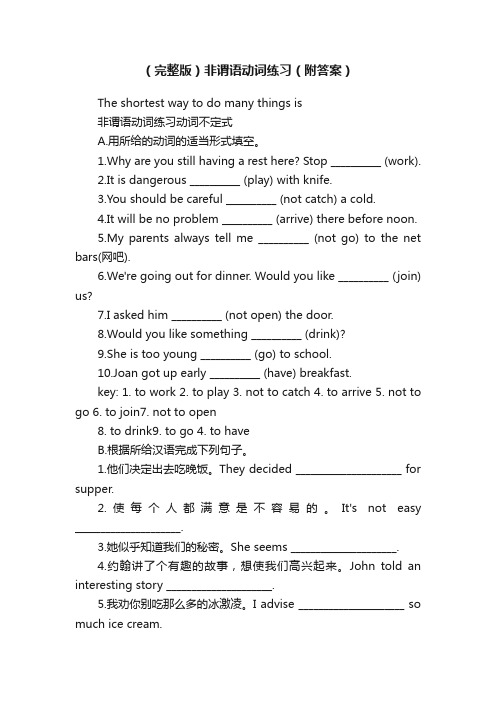
(完整版)非谓语动词练习(附答案)The shortest way to do many things is非谓语动词练习动词不定式A.用所给的动词的适当形式填空。
1.Why are you still having a rest here? Stop __________ (work).2.It is dangerous __________ (play) with knife.3.You should be careful __________ (not catch) a cold.4.It will be no problem __________ (arrive) there before noon.5.My parents always tell me __________ (not go) to the net bars(网吧).6.We're going out for dinner. Would you like __________ (join) us?7.I asked him __________ (not open) the door.8.Would you like something __________ (drink)?9.She is too young __________ (go) to school.10.Joan got up early __________ (have) breakfast.key: 1. to work 2. to play 3. not to catch 4. to arrive 5. not to go 6. to join7. not to open8. to drink9. to go 4. to haveB.根据所给汉语完成下列句子。
1.他们决定出去吃晚饭。
They decided _____________________ for supper.2.使每个人都满意是不容易的。
【英语】非谓语动词讲解及练习(含答案)

【英语】非谓语动词解说及练习(含答案)一、单项选择非谓语动词1.The film star wears sunglasses. Therefore, he can go shopping without ___________. A.recognizing B.being recognizedC. having recognized D. having been recognized【答案】 B【分析】试题剖析:本题考察动词的非谓语动词形式。
句意:那位电影明星戴上墨镜。
所以,他去买东西不会被认出来。
依据题中的介词without判断,今后应当使用动词的动名词形式,因为他是被人认出的,所以应当用动名词的被动式,所以选B。
考点:考察非谓语动词的用法2.(天津 ) The hospital has recently obtained new medical equipment, ________ more patients to be treated.A. being allowed B.allowingC. having allowed D. allowed【答案】 B【分析】【详解】考察非谓语动词。
句意:近期这个医院购进了新的医疗设施,同意更多的病人被治疗。
前句购进医疗设施和后边同意更多的病人被治疗之间是必定的结果关系,用doing 即此刻分词作结果状语,表示理所应当的结果。
A. being allowed 表示被动且正在进行; C. having allowed 重申先于谓语动词发生; D. allowed 表示被动且达成,应选B。
【点睛】判断非谓语动词的形式的第一步是剖析句子成分,看是用谓语动词仍是非谓语动词,确立了是非谓语动词,还要判断非谓语动词的成分,和这个动词和逻辑主语的关系。
3.________ by the advances in technology, many farmers have set up wind farms on their land. A. Being encouraged B.EncouragingC. Encouraged D. Having encouraged【答案】 C【分析】试题剖析:考察过去分词做状语:句意:被科技的进步激励着,好多农民在自己的土地上建起了风力发电厂。
初中英语语法之非谓语动词1讲解-练习-答案
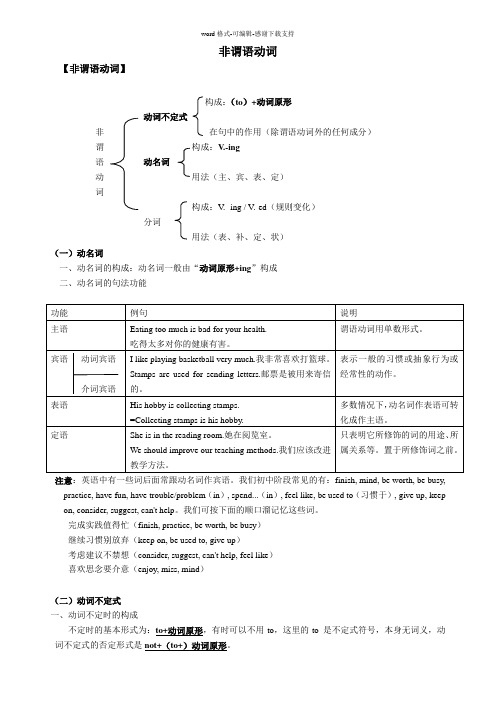
非谓语动词【非谓语动词】构成:(to)+动词原形动词不定式非在句中的作用(除谓语动词外的任何成分)谓构成:V.-ing语动名词动用法(主、宾、表、定)词构成:V. -ing / V.-ed(规则变化)分词用法(表、补、定、状)(一)动名词一、动名词的构成:动名词一般由“动词原形+ing”构成二、动名词的句法功能注意:英语中有一些词后面常跟动名词作宾语。
我们初中阶段常见的有:finish, mind, be worth, be busy, practice, have fun, have trouble/problem(in), spend...(in), feel like, be used to(习惯于), give up, keep on, consider, suggest, can't help。
我们可按下面的顺口溜记忆这些词。
完成实践值得忙(finish, practice, be worth, be busy)继续习惯别放弃(keep on, be used to, give up)考虑建议不禁想(consider, suggest, can't help, feel like)喜欢思念要介意(enjoy, miss, mind)(二)动词不定式一、动词不定时的构成不定时的基本形式为:to+动词原形,有时可以不用to,这里的to 是不定式符号,本身无词义,动词不定式的否定形式是not+(to+)动词原形。
1. 不定式作主语动词不定式作主语时,常用it作形式主语,而将真正的主语放在句末如:To learn English well is useful.→It is useful to learn English well.It’s important for us to protect the environment.注意:在kind,good,nice,clever等表示人的品质的形容词后,不用for而用of。
初中必备英语非谓语动词技巧全解及练习题(含答案)含解析
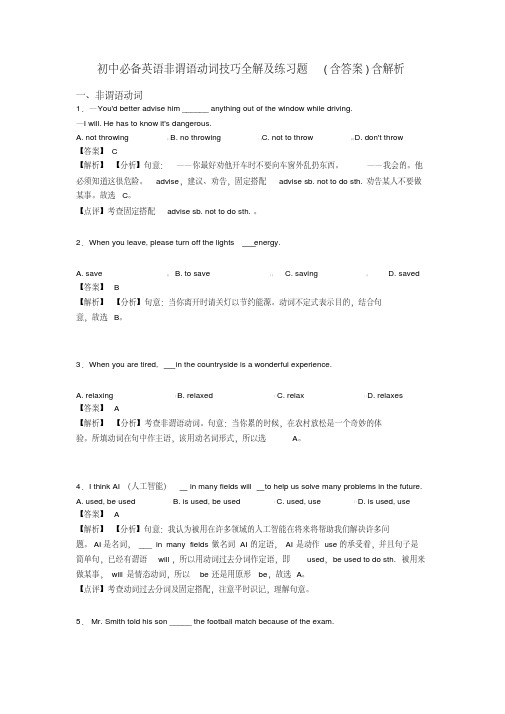
初中必备英语非谓语动词技巧全解及练习题(含答案)含解析一、非谓语动词1.—You'd better advise him ______ anything out of the window while driving.—I will. He has to know it's dangerous.A. not throwingB. no throwingC. not to throwD. don't throw【答案】C【解析】【分析】句意:——你最好劝他开车时不要向车窗外乱扔东西。
——我会的。
他必须知道这很危险。
advise,建议、劝告,固定搭配advise sb. not to do sth.劝告某人不要做某事。
故选C。
【点评】考查固定搭配advise sb. not to do sth.。
2.When you leave, please turn off the lights energy.A. saveB. to saveC. savingD. saved【答案】 B【解析】【分析】句意:当你离开时请关灯以节约能源。
动词不定式表示目的,结合句意,故选B。
3.When you are tired, in the countryside is a wonderful experience.A. relaxingB. relaxedC. relaxD. relaxes【答案】 A【解析】【分析】考查非谓语动词。
句意:当你累的时候,在农村放松是一个奇妙的体验。
所填动词在句中作主语,该用动名词形式,所以选A。
4.I think AI (人工智能) in many fields will to help us solve many problems in the future.A. used, be usedB. is used, be usedC. used, useD. is used, use【答案】 A【解析】【分析】句意:我认为被用在许多领域的人工智能在将来将帮助我们解决许多问题。
(英语)必备英语非谓语动词技巧全解及练习题(含答案)及解析

(英语)必备英语非谓语动词技巧全解及练习题(含答案)及解析一、非谓语动词1.________, he has to listen to tapes every day.A. To learn English wellB. Learn English wellC. Learning English well【答案】 A【解析】【分析】句意:为了学好英语,他不得不每天听录音。
选项部分在句子中表示目的,故用动词不定式,故选A。
【点评】此题考查动词不定式。
注意动词不定式的成分。
2.The workers were made from morning to night in the past.A. workedB. to workC. workD. working【答案】 B【解析】【分析】句意:在过去工人们被迫从早晨工作到晚上make sb do sth让某人做某事,其被动语态形式sb be made to do sth所以选B。
3.To keep children away from danger,we warn parents ________ children at home alone.A. leaveB. to leaveC. not leaveD. not to leave【答案】 D【解析】【分析】考查不定式短语.句意:为了让孩子们远离危险,我们警告家长不要把孩子单独留在家里.warn sb not to do sth警告某人不要做某事.根据题干To keep children away from danger为了让孩子们远离危险,可知应说我们警告家长不要把孩子单独留在家里.故选D.4.—In my opinion, animals shouldn't be kept for fun.— I think so. Forests are the best places for animals ______________.A. liveB. livingC. to liveD. to live in【答案】 D【解析】【分析】句意:——在我看来,动物不应该被用来取乐。
八年级英语句型及语法(非谓语动词)及答案解析
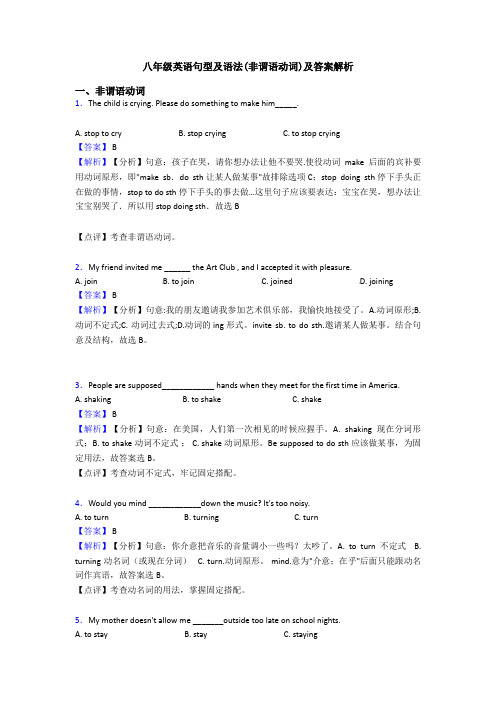
八年级英语句型及语法(非谓语动词)及答案解析一、非谓语动词1.The child is crying. Please do something to make him_____.A. stop to cryB. stop cryingC. to stop crying【答案】 B【解析】【分析】句意:孩子在哭,请你想办法让他不要哭.使役动词make后面的宾补要用动词原形,即"make sb.do sth让某人做某事"故排除选项C;stop doing sth停下手头正在做的事情,stop to do sth停下手头的事去做…这里句子应该要表达:宝宝在哭,想办法让宝宝别哭了.所以用stop doing sth.故选B【点评】考查非谓语动词。
2.My friend invited me ______ the Art Club , and I accepted it with pleasure.A. joinB. to joinC. joinedD. joining【答案】 B【解析】【分析】句意:我的朋友邀请我参加艺术俱乐部,我愉快地接受了。
A.动词原形;B.动词不定式;C. 动词过去式;D.动词的ing形式。
invite sb. to do sth.邀请某人做某事。
结合句意及结构,故选B。
3.People are supposed____________ hands when they meet for the first time in America.A. shakingB. to shakeC. shake【答案】 B【解析】【分析】句意:在美国,人们第一次相见的时候应握手。
A. shaking现在分词形式;B. to shake动词不定式; C. shake动词原形。
Be supposed to do sth应该做某事,为固定用法,故答案选B。
【点评】考查动词不定式,牢记固定搭配。
非谓语动词讲解(附练习及答案)
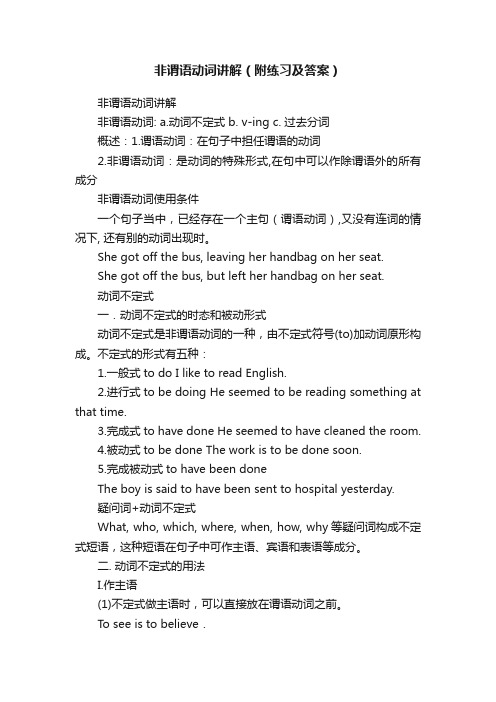
非谓语动词讲解(附练习及答案)非谓语动词讲解非谓语动词: a.动词不定式 b. v-ing c. 过去分词概述:1.谓语动词:在句子中担任谓语的动词2.非谓语动词:是动词的特殊形式,在句中可以作除谓语外的所有成分非谓语动词使用条件一个句子当中,已经存在一个主句(谓语动词),又没有连词的情况下, 还有别的动词出现时。
She got off the bus, leaving her handbag on her seat.She got off the bus, but left her handbag on her seat.动词不定式一.动词不定式的时态和被动形式动词不定式是非谓语动词的一种,由不定式符号(to)加动词原形构成。
不定式的形式有五种:1.一般式to do I like to read English.2.进行式to be doing He seemed to be reading something at that time.3.完成式to have done He seemed to have cleaned the room.4.被动式to be done The work is to be done soon.5.完成被动式to have been doneThe boy is said to have been sent to hospital yesterday.疑问词+动词不定式What, who, which, where, when, how, why等疑问词构成不定式短语,这种短语在句子中可作主语、宾语和表语等成分。
二. 动词不定式的用法I.作主语(1)不定式做主语时,可以直接放在谓语动词之前。
To see is to believe.Not to get there in time is your fault.(2)注:常用it做形式主语,将to do位于之后,使句子保持平衡。
初中英语语法知识—非谓语动词的全集汇编含答案解析(1)

一、选择题1.—Why are you so excited today?—We were told ____ a picnic this weekend.A.have B.to haveC.having D.had2.She couldn’t help ________ when she heard the death of her grandmother.A.cry B.to cry C.crying D.to crying 3.(2016天津中考)I wanted to see the Beijing Opera, so Lingling offered me to watch an opera.A.took B.takes C.to take D.taking4.I used to . But now I get used to doing everything. I’m successful at last.A.give up; keeping B.giving up; keepingC.giving up; keep D.give up; keep5.________TV too much is bad for your eyes.A.Watching B.Watch C.Watches D.Watched6.---I think you should stop ______ him in English.---I see. He can’t understand English at all. Let me try in French.A.talking to B.to talk toC.talk to D.to talking to7.—What terrible weather!I simply can’t get the car________.—Why not try________the engine with some hot water?A.started; filling B.to start; filling C.started; to fill D.to start; to fill 8.—Do you know whom they will have ________the parts of car together?—Sorry,I have no idea.A.fix B.fixed C.to fix D.fixing9.My father likes ________football matches on TV.A.watch B.watching C.watches D.to watching 10.The opera is very difficult. I hope ________ more next time.A.understand B.understanding C.to understand D.understood 11.At the party, Lucy ________ like a Mickey Mouse to make us ________.A.dressed up, laugh B.dressed up, to laugh C.dressed on, laugh D.dressed on, to laugh 12.—What about_____________?—That’s a good idea,A.go shopping B.going shop C.going shopping D.go to shop 13.Let’s go to that shop________some school things.A.buying B.to buy C.bought14.In the Science Museum, the children are to see so many things.A.surprised; amazed B.surprised; amazingC.surprising; amazing D.surprising; amazed15.—When can you finish ________ that book?—This afternoon. Then you can read it. It’s really interesting.A.read B.to read C.reading 16.(2016·老河口期考)—What did the guard say to you just now?—He warned us_______any farther. There's danger ahead.A.didn't walk B.not to walk C.walk D.to walk 17.It's worth ________ a talk with your friends before you make your final decision. A.to have B.having C.have D.has 18.The girl is so helpful that she devoted all her spare time she had ______ others.A.helping B.to helping C.to help D.helped 19.How lucky Peter was! Some policemen arrived in time and __________ him out. A.managed to help B.tried to help C.succeeded to help D.tried helping 20.We should do everything we can________the endangered birds.A.protect B.protecting C.to protect D.protected 21.The boy didn’t get an education so he has problems________ a job.A.to find B.finding C.find D.found 22.Sandy likes ________ TV. She ________ TV every day.A.watching; watching B.watch; watchesC.to watch; is watching D.watching; watches23.Thank you for________ me a nice gift.A.send B.sending C.sends D.to send 24.Practicing English as often as you can is the best way ________ it .A.learn B.learning C.to learn D.for learn 25.I’m looking forward to _________int o a good university.A.get B.got C.getting D.gets 26.Our class teacher told us ________ in the playground now for it is wet now.A.to play B.not to play C.played D.don’t play 27.Class Four plans________ a meeting about the school art festival tomorrow. A.have B.to have C.has D.are having 28.—It’s too hot. Would you mind my________ the window?— ________, please do it now.A.to open; OK B.opening; Certainly not C.opening; Of course D.to open; Good idea【参考答案】***试卷处理标记,请不要删除一、选择题1.B解析:B【解析】【分析】【详解】句意:——你今天为什么这么兴奋?——我们被告知这个周末去野餐。
非谓语动词讲解及练习(含答案)

非谓语动词讲解及练习(含答案)一、单项选择非谓语动词1.Moving to Canada for higher education has been exciting. On the first day of term, there were crowds of people in the dormitory, all where they should go.A.looked for B.looking for C.were looking for D.had been looking for【答案】B【解析】【详解】考查非谓语动词。
句意:到加拿大接受高等教育令人兴奋,开学第一天,宿舍挤满了人,大家都在找自己该去的地方。
People与look for是逻辑上的主谓关系,表示主动,用现在分词作伴随状语,故B项正确。
2.Pressed from his parents, and ____ that he has wasted too much time, the boy is determined to stop playing video games.A.realizing B.realizedC.to realize D.being realized【答案】A【解析】试题分析:考查非谓语动词的用法。
句意:被父母迫使同时自己也意识到他已经浪费了太多时间,这个男孩决定停止玩电脑游戏。
首先要弄清楚本句中的and连接的成分是非谓语动词做状语,主语the boy与press是被动关系,但是与realize是主动,所以是现在分词做状语,选A。
3.—Come on,please give me some ideas about the project.—Sorry.With so much work _______ my mind,I almost break down.A.filled B.filling C.to fill D.being filled【答案】B【解析】“with+复合结构”在句中表状态或说明背景情况,常作伴随、方式、原因、条件等状语,该结构由“名词(代词)+不定式、形容词、副词、介词短语、动词-ing形式、动词-ed形式等”构成。
- 1、下载文档前请自行甄别文档内容的完整性,平台不提供额外的编辑、内容补充、找答案等附加服务。
- 2、"仅部分预览"的文档,不可在线预览部分如存在完整性等问题,可反馈申请退款(可完整预览的文档不适用该条件!)。
- 3、如文档侵犯您的权益,请联系客服反馈,我们会尽快为您处理(人工客服工作时间:9:00-18:30)。
非谓语动词【非谓语动词】构成:(to)+动词原形动词不定式非在句中的作用(除谓语动词外的任何成分)谓构成:V.-ing语动名词动用法(主、宾、表、定)词构成:V. -ing / V.-ed(规则变化)分词用法(表、补、定、状)(一)动名词一、动名词的构成:动名词一般由“动词原形+ing”构成二、动名词的句法功能注意:英语中有一些词后面常跟动名词作宾语。
我们初中阶段常见的有:finish, mind, be worth, be busy, practice, have fun, have trouble/problem(in), spend...(in), feel like, be used to(习惯于), give up, keep on, consider, suggest, can't help。
我们可按下面的顺口溜记忆这些词。
完成实践值得忙(finish, practice, be worth, be busy)继续习惯别放弃(keep on, be used to, give up)考虑建议不禁想(consider, suggest, can't help, feel like)喜欢思念要介意(enjoy, miss, mind)(二)动词不定式一、动词不定时的构成不定时的基本形式为:to+动词原形,有时可以不用to,这里的to 是不定式符号,本身无词义,动词不定式的否定形式是not+(to+)动词原形。
1. 不定式作主语动词不定式作主语时,常用it作形式主语,而将真正的主语放在句末如:To learn English well is useful.→It is useful to learn English well.It’s important for us to protect the environment.注意:在kind,good,nice,clever等表示人的品质的形容词后,不用for而用of。
如:It's very kind of you to help me. 你帮助我真是太好啦。
It's very clever of you to do like that. 你那样做真是太聪明啦。
2. 不定式作宾语① 有些谓语动词后只能用不定式作宾语,常见的这类词是表示命令、打算或希望的,如:would like, like, want, wish, hope, decide, plan, expect等。
如:Would you like to see a film this evening? 你今晚想去看电影吗?②在find, think后跟不定式作宾语时,常用it代替,而将真正的宾语放在后面。
如:I find it easy to read English every day.③常见的一些不带to的动词不定式Why not do..., Why don't you do..., had better(not)do..., would rather do,could/would/will you please(not)do...I would rather stay in the room.我宁愿待在房间里。
3. 不定式作宾语补足语不定式作宾语补足语时与宾语有逻辑上的主谓关系。
如:Lucy asked him to turn down the radio. 露西让他关小收音机。
tell, ask, want, allow, get, would like, encourage后常跟动词不定式作宾语补足语。
如:My mother encourages me to learn Japanese. 我妈妈鼓励我学日语。
注意:还有一些使役动词和感官动词也用不定式作宾补,这时不定式要省略to。
这些动词有:一感(feel)、二听(hear, listen to)、三让(let, make, have)、四看(look at, see, watch, notice)。
但变被动语态时,必须加上My friends were made to work the whole night by the boss. 老板让我的朋友们工作了一整夜。
4. 不定式作定语①不定式作定语时,应放在名词之后。
它与名词有逻辑上的动宾关系。
②如果是不及物动词,且与所修饰的词之间有动宾关系,要在不定式后加上适当的介词。
There is nothing to worry about. 没有什么可担心的。
5.不定式常和疑问词what, which, when, where, how连用,相当于一个宾语从句。
如:The teacher is telling the students what to do. 老师正告诉学生们做什么。
He didn't know where to go. 他不知道去哪里。
例题( )1. Tom's mother told him _______ eating too much meat.A: stopping B: to stop C: stops D: stopped( )2. We don't know ________ it next. Let's go and ask Mr. Li.A: what to do B: to do what C: whether to do D: to do whether( )3. How kind you are! You always do what you can _______me.A: help B: helping C: to help D: helps( )4 Drivers shouldn't be allowed ________after drinking, or they will break the law.A: drive B: driving C: to drive( )5. Water Park is a good place________.A: to have fun B: have fun C: having fun D: to have a fun( )6. Take time to relax by listening to music, reading a book or just spending some time alone. Relaxing allows you _______to your studies with more energy.A: return B: to return C: returning( )7. Nick, would you mind ________those old jeans? They look terrible.A: not to wear B: not wear C: wearing not D: not wearing( )8. —_______ a volunteer is great.—I think so. Some of us want _______volunteers for the London Olympics.A: Being;being B: To be;being C: Being;to be D: To be;to be( )9.—Don't forget ______your history and politics books tomorrow morning.—Thanks. I won't.A: bring B: to bring C: bringing( )10.—What about _______a rest?—OK. Let's go out and have a walk.A: to take B: takes C: taking( )11. —I like this set of sofa so much, but I don't know ______it in my small house.—You're supposed to put it in the living room.A: where to put B: why to put C: how to put( )12. While we were running on the playground, Jack suddenly stopped ______and lay on the ground, so we all stopped _______what was wrong with him.A: to run; to see B: running; seeing C: running; to see( )13. May I have a rest? I have already finished ______the report.A: write B: writing C: to write D: written( )14.—I feel a bit hungry now.—Why not _______for dinner with us?A: go B: did you go C: to go D: do you go练习( )1. Granny often tells us ________water in our daily life.A: save B: saving C: to save D: saves( )2. Richard turned off the computer after he had finished ________the email.A: write B: to write C: writing D: wrote( )3.—We can use QQ to chat with each other on the Internet.—Really? Will you please show me ______it?A: how to use B: what to use C: how can I use D: what can I use( )4.—Where's your brother now,Bob?—I saw him ________ in the street a moment ago and I told him _______.A: playing;don't do so B: playing;not to do so C: play;to do so( )5. As teenagers, we're old enough _______with housework. We can help set the table, wash the dishes and clean our own rooms.A: to help B: helping C: helped( )6. Nancy is really a hard-working student. We often see her _______books in the classroom.A: read B: to read C: reads( )7 Mrs. Smith made her students _______the compositions three times a week.A: write B: to write C: written D: writing( )8.Tom often makes his sister , but yesterday he was made by his sister.A: cry; to cry B: to cry; cry C:cry; cry D: to cry; to cry( )9. You'd better _______ too much time playing computer games.A: don't spend B: not to spend C: to not spend D: not spend( )10. More and more young people are trying to do something _______the old.A: served B: to serve C: serve D: serves( )11. Why not _______ an English club to practice _______ English?A. to join; to speakB. join; speakingC. join; to speakD. to join; speaking( )12. When we came to the gate, he stopped _________ me go in first.A. to letB. to tellC. to allowD. to ask( )13. She saw some boys _________ soccer on the playground when she was on the way to the classroom.A. playedB. to playC. playing( )14. —How about going shopping this weekend, Peter?—Sorry, I prefer _________ rather than _________.A. to stay at home; go outB. to go out; stay at homeC. staying at home; go outD. Going out; stay at home( )15. It's a good habit _________ every day.A. to keep doing exerciseB. to stay up lateC. to make much noiseD. to too much( )16. —It's hot. Would you mind my _________ the window.—__________. Do it as you like, please!A. to open; OKB. opening; Certainly notC. closing; Of courseD. Open; Good idea ( )17. Who do you think you'd like _________ with you, a boy or a girl?A. to let to goB. letting to goC. to let goD. let go( )18. The house was so dirty. They decided _________.A. clean it upB. to clean it upC. clean up itD. cleaning up( )19. I heard someone _______ the door and .A. open; come inB. to open; to come inC. open; come intoD. to open; to come into ( )20. The girl was heard _________ the piano in the next room.A. playsB. to playC. playedD. play。
